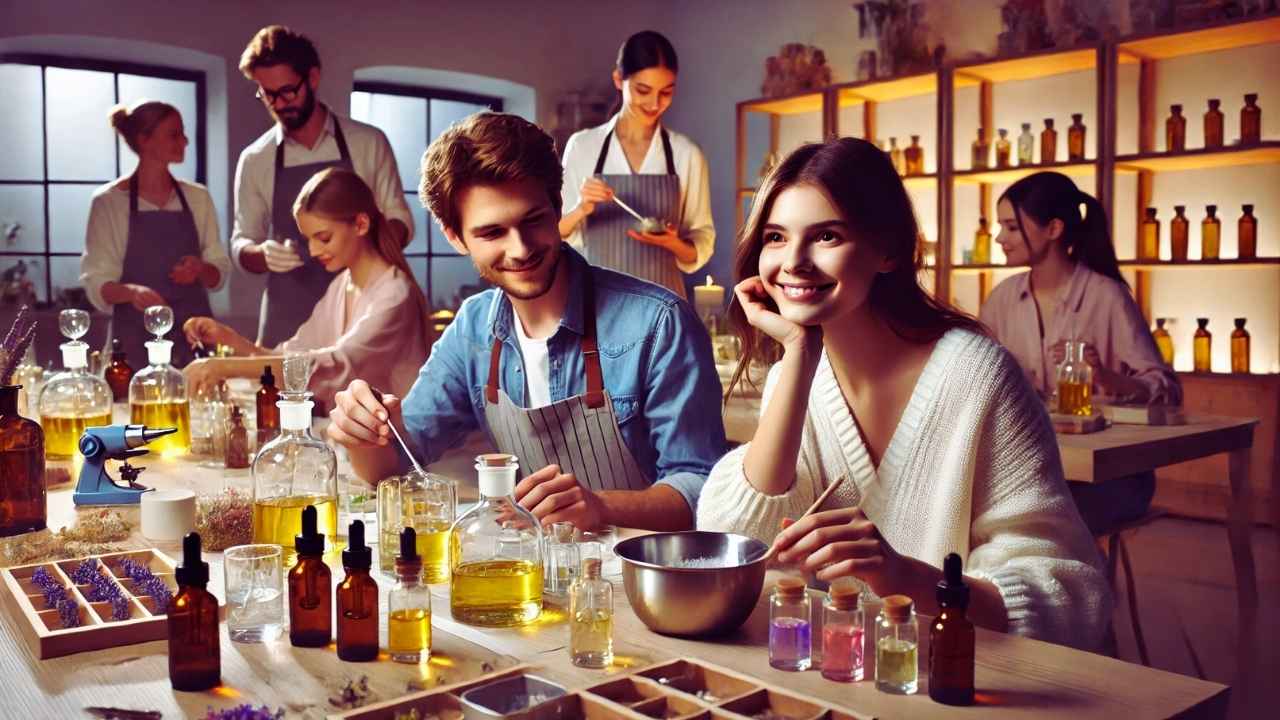I have always enjoyed making homemade fragrances. The tradition goes back centuries. Ancient cultures used floral and wood extracts to craft personal scents. This history shaped modern perfume making. Now we can easily learn how to make a perfume at home with natural ingredients. That means fewer chemicals and more room for creativity.
You only need essential oils, a carrier, and some basic tools. When you learn how to make perfume with essential oils, you avoid synthetic additives. You also control each aroma note. If you want to create a soothing lavender blend or a bright citrus splash, you can mix oils that match your mood. That is why so many people love do-it-yourself projects.
I find that DIY perfume offers flexibility. You can make a small roll-on or a larger spray. You can also tweak your formula for better longevity or gentler projection. The result is a custom scent that fits your style. Once you master these basics, you can even show friends how to make homemade perfume. It is a fun way to share natural fragrances.
Basics of Perfume Making
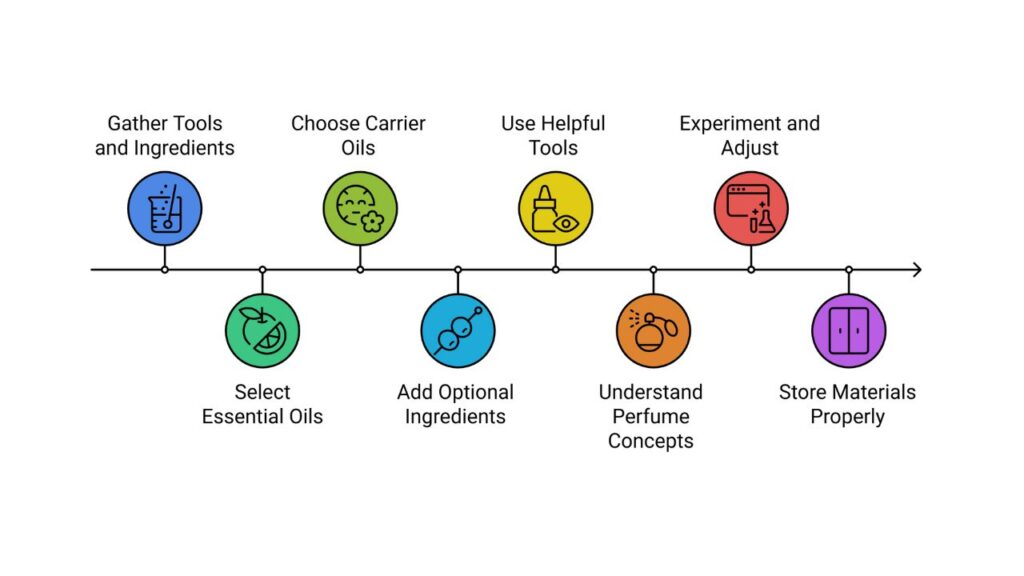
I like to begin each perfume project by gathering the correct tools and ingredients. You do not need fancy equipment. If you are wondering how to make perfume with essential oils, it helps to have simple household items. I use droppers, small glass beakers, funnels, and clean mixing rods.
Essential Oils
These are the heart of any DIY fragrance. High-quality oils make a difference. If you want to know how to make oil perfume or an all-natural body spray, pick oils that match your desired aroma. For florals like lavender or jasmine, look for steam-distilled extracts. For citrus notes, cold-pressed versions deliver fresh scents. If you want to create a bold cologne, you might pick woody or spicy oils.
Carrier Oils
Carrier oils dilute essential oils so they do not irritate your skin. You can try jojoba, fractionated coconut oil, or sweet almond oil. Those options have mild scents, so they do not overshadow your chosen essential oils. If your goal is how to make oil perfume at home, carrier oils are key.
Additional Ingredients
- Alcohol (Optional): Some prefer an alcohol base because it lifts the scent.
- Distilled Water: Useful if you make a body mist or prefer a lighter touch.
- Fixatives: Natural fixatives include benzoin resin or orris root. They help scents last longer.
Helpful Tools
- Measuring Pipettes: You can measure each drop for consistent formulas.
- Glass Vials: They store trial blends.
- Labels and Pen: Mark your samples so you remember each recipe.
Basic Perfume Concepts
- Top, Middle, Base Notes: Top notes evaporate first. Middle notes form the main body. Base notes linger the longest.
- Blending Ratios: Beginners often use 30% top notes, 50% middle notes, and 20% base notes. That is flexible.
- Testing and Adjusting: Start small. Tweak after you sniff the dry-down stage.
Example Table: Common Essential Oils by Note
| Note | Oil Examples | Aroma Quality |
|---|---|---|
| Top | Lemon, Bergamot, Peppermint | Bright and uplifting |
| Middle | Lavender, Rose, Geranium | Floral or herbal |
| Base | Patchouli, Sandalwood, Amber | Deep and lingering |
You can see that each oil has a unique role. If you learn how to blend essential oils for perfume carefully, you will create a balanced scent. For instance, a citrus top note can wake up the composition, while a woody base adds depth.
Experimentation is part of the fun. You may want how to make your own perfume oil that’s fresh and energizing. Or you might aim for a relaxing lavender-based roll-on. Either way, you can discover new blends as you practice more.
Finally, remember the importance of storing your materials properly. Keep them in a cool, dark space. That prevents oxidation, so your oils last longer. If you do this well, your homemade perfume remains potent and pure.
Types of Perfumes
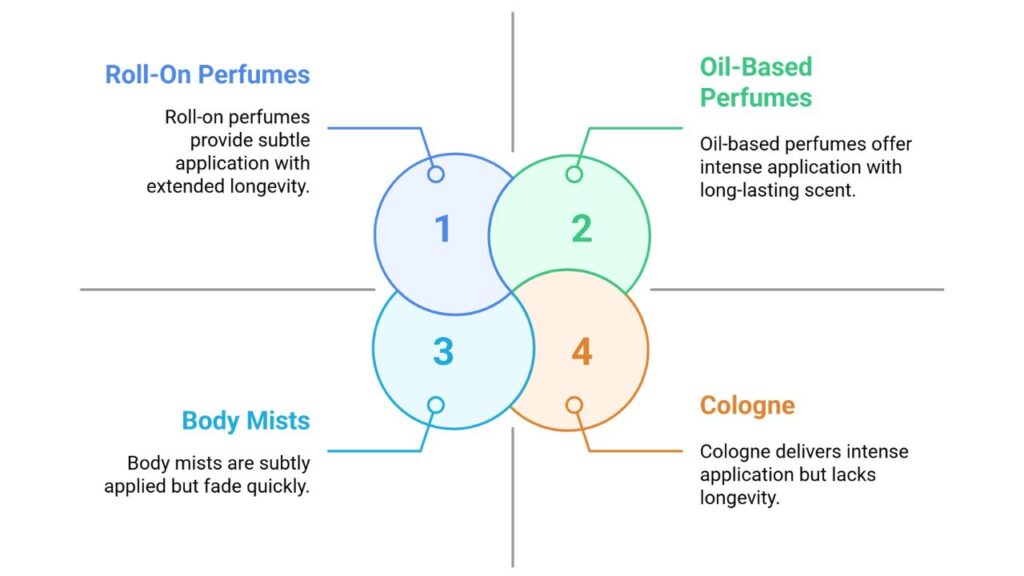
I love exploring all the perfume formats I can make at home. Some days I want an oil-based roll-on. Other times I need a refreshing body mist. Knowing the differences helps me decide which approach to try.
Let’s dive into these main categories when you want to learn how to make perfume with essential oils.
Oil-Based Perfumes
These are popular for their gentle scent release. You blend essential oils with carriers like jojoba or fractionated coconut oil. If you want to know how to make oil based perfume that nourishes skin, go for sweet almond oil.
Oil-based perfumes usually last longer on the skin. They do not evaporate quickly. If you ask, “How do I make perfume with essential oils?” This method is simple. Just mix the oils at a ratio that suits your preference, then let it sit for a day.
Pros
- Mild on sensitive skin
- More moisturizing
- Subtle scent throw
Cons
- Might stain clothing if overapplied
- Slower absorption
Roll-On Perfumes
I like the compact roll-on style. It is easy to tuck in a bag. You can do how to make roll on perfume with fragrance oils or essential oils. You fill a small roller bottle with a carrier oil and your chosen essential oils. The roller top controls the amount of perfume you apply. That helps if you want a quick dab of fragrance on your wrist or neck.
Pros
- Spill-proof
- Travel-friendly
- Simple application
Cons
- Limited spray distance
- Requires direct contact with the skin
Body Mists
If you prefer a light, airy spritz, body mist is ideal. You can blend essential oils with distilled water or a small amount of alcohol. That approach keeps the scent breezy. For tips on how to make a body mist with essential oils, keep the ratio lower to avoid overwhelming. Body mists usually fade faster, so reapply when you want a boost.
Pros
- Refreshing feel
- Good for warm weather
- Fewer heavy notes
Cons
- Shorter longevity
- May need shaking if you skip an emulsifier
Cologne
Cologne has a lower concentration of aromatic oils but often includes robust woody or spicy notes. People search for how to make cologne from essential oils to craft masculine or unisex blends. Typical cologne might have about 5% to 8% fragrance oils in an alcohol base. If you want a bolder statement, increase the ratio slightly.
Pros
- Lively projection
- Crisp, bright vibe
- Works well for daily wear
Cons
- May irritate very sensitive skin
- Less intense than pure parfum
When you grasp these categories, you can pick the style that fits your mood. If you love subtle aromas, go for an oil-based roll-on. If you want a fresh blast, opt for a body mist. If you crave a refined masculine edge, try a cologne with essential oils. The best part is that you can mix and match ingredients to make each formula your own.
Creating Your Perfume Blend
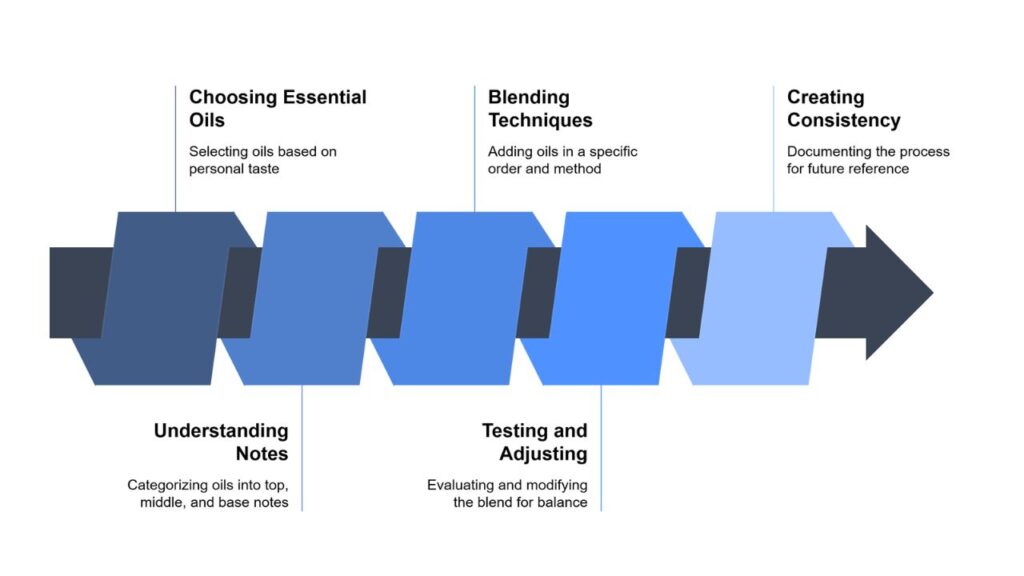
I find this step the most fun. It is the stage where you choose oils, combine them, and see a new scent emerge. If you want to know how to make perfume with essential oils, the blending process is key. The main concept is layering notes. Each essential oil has a top, middle, or base note.
Choosing Essential Oils
Pick oils that reflect your taste. If you love florals, choose rose or geranium. For something earthy, try vetiver or patchouli. If you enjoy bright scents, add lemon or bergamot. I often gather my top, middle, and base oils in small droppers. That speeds up the mixing process.
Example: Citrus Floral Blend
- Top: Grapefruit (10 drops)
- Middle: Lavender (15 drops)
- Base: Cedarwood (5 drops)
Understanding Notes
- Top Notes: Evaporate fast. Provide the initial impression.
- Middle Notes: Form the heart. They surface after top notes fade.
- Base Notes: Linger. They bind the scent together.
I aim for a ratio that might be 30% top, 50% middle, 20% base. You can tweak that to your preference. If you want a heavier scent, add more base notes. If you want something light, add more top notes.
Blending Techniques
- Step-by-Step Addition: I start with base notes, add middle notes next, then finish with top notes.
- Swirling or Gently Shaking: I swirl the container instead of shaking too hard. That prevents foam or unwanted reactions.
- Rest Period: Let the blend settle. Some perfumers wait a day or two before the next test sniff.
Testing and Adjusting
I place a drop on a blotter strip or cotton pad. I sniff after a few minutes, then again after an hour. That reveals how the notes shift. If the top notes dominate too strongly, I reduce them. If the base is weak, I add more. This trial-and-error approach is part of learning how do you make perfume from essential oils that smells balanced.
Creating Consistency
For repeated success, keep a journal. Write down the number of drops for each oil. If you accidentally add an extra drop of patchouli, note that too. That helps you replicate good results or avoid mistakes.
Quick Tip:
- Use warm water in a bowl to gently heat the bottle if the carrier oil gets thick. That loosens the viscosity, making blending smoother.
Blending is an art. You can experiment with fruity, floral, musky, or even smoky profiles. Over time, your nose gets better at picking out details. You learn how to make a perfume from essential oils that matches your personality.
Making Oil-Based Perfume
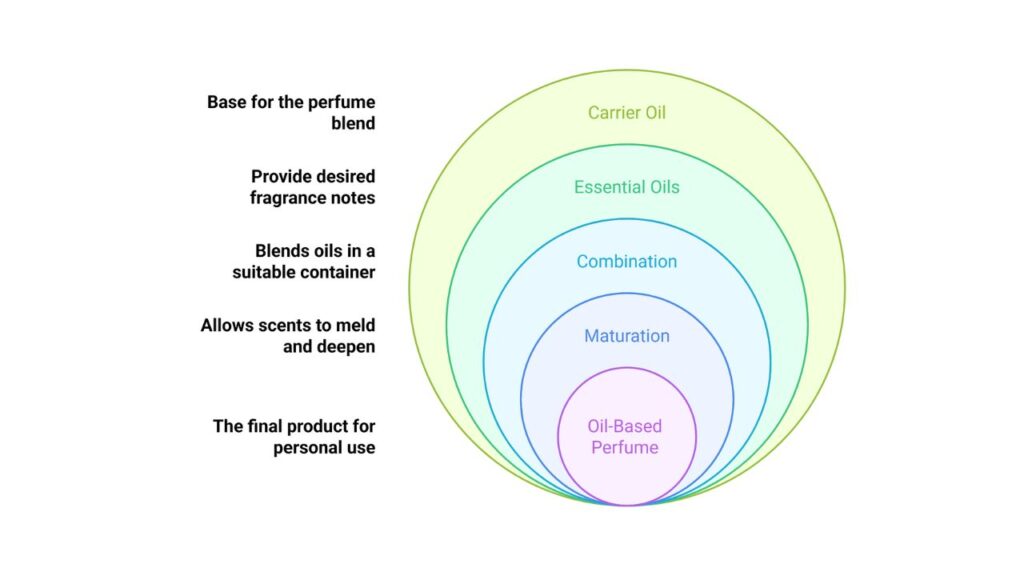
Oil-based perfume offers a gentle and moisturizing fragrance. I find it perfect for people who want a subtle scent that melts into the skin. If you want to know how to make oil perfume at home, follow these steps.
1. Choose a Carrier Oil
Carrier oil is the base. Popular choices are jojoba, fractionated coconut, or sweet almond. If you ask, “How to make an oil based perfume that lasts?” pick a stable oil like jojoba. That helps preserve your scent longer.
2. Select Essential Oils
Go for a balanced blend of top, middle, and base notes. Think about how you want the perfume to smell after several hours. If you like a floral touch, add rose or geranium. If you want a warm finish, try sandalwood.
3. Combine in a Glass Bottle
- Measure the carrier oil into a small bottle. I use a 10 ml roller for convenience.
- Count your essential oil drops. If you prefer a strong aroma, add more. But keep the total around 20 to 30 drops for a 10 ml roller.
- Gently swirl. Do not shake aggressively.
4. Let It Mature
I recommend waiting at least 24 hours before using the perfume. The oils need time to meld. If you can wait longer, that helps the scent deepen.
5. Test and Adjust
Roll a bit on your wrist. Smell after a few minutes. If it seems too faint, add a few more drops of the main oil. If it is too strong, dilute with extra carrier.
Example Simple Recipe
- 10 ml jojoba oil
- 10 drops lavender (middle)
- 5 drops lemon (top)
- 5 drops frankincense (base)
After swirling, I check the balance. I might add 2 more drops of lemon if I want it brighter. If I want longevity, I add 2 drops of patchouli or vetiver. That is how to make long lasting perfume from essential oils in an oil base.
Oil-based perfumes are easy to store. They usually do not evaporate quickly. Keep them away from direct sun. That helps them remain fresh. This method is ideal for quick gifts or personal daily use. It is also gentle on sensitive skin.
Making Perfume with Alcohol
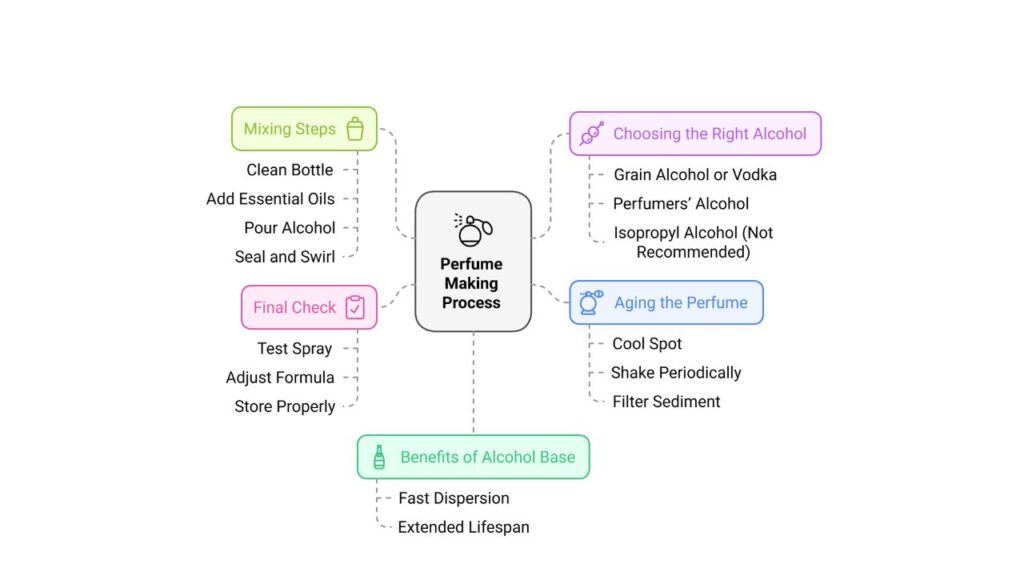
Alcohol-based perfumes project more strongly. If you want a lasting sillage, you might prefer ethanol or perfumer’s alcohol. Many folks ask, “How to make perfume with essential oils using alcohol?” It is a straightforward process.
1. Benefits of Alcohol Base
Alcohol disperses aromatic molecules fast. That gives you an immediate burst of scent. It also extends the lifespan on the skin. This is especially handy if you want a bold fragrance.
2. Choosing the Right Alcohol
- Grain Alcohol or Vodka: Must be at least 80-100 proof.
- Perfumers’ Alcohol: Specially formulated for fragrance.
- Isopropyl Alcohol: Not recommended for final perfume. It can smell harsh.
3. Mixing Steps
- Start with a clean glass bottle.
- Add your essential oils. Keep track of the drops. This helps you refine future formulas.
- Pour in the alcohol. Aim for around 70-90% alcohol to 10-30% oils. That ratio depends on how strong you want it.
- Seal the bottle. Gently swirl.
4. Aging the Perfume
Let the blend sit for a couple of weeks in a cool spot. Some experts age their perfumes for a month or more. That allows the notes to harmonize. Shake gently every few days. After aging, you can filter out any sediment if you used resins or heavy oils.
5. Final Check
Do a test spray. If it seems off balance, add or reduce certain oils. If it’s too strong, dilute with more alcohol. If you prefer a slightly sweeter finish, add a touch of glycerin or mild fixative.
Example Formula
- 10 ml perfumer’s alcohol
- 20 drops essential oil blend (top, middle, base)
- Mix, age for two weeks, then use
You get a crisp, professional feel. That is why people who explore how to make perfume with fragrance oil or essential oils often end up using an alcohol base. It provides a classic experience. If you want a gentler approach, stick to short aging periods or lower oil ratios.
Alcohol-based perfumes can last several months or longer. Store them in dark glass bottles. Keep them away from heat. With proper care, you have a homemade fragrance that competes with store-bought options.

Specialized Perfume Types
I enjoy branching out beyond basic oil or alcohol blends. If you want to learn how to make cologne from essential oils or a gentle hair mist, you can adapt the same concepts. Here are a few fun specialties.
Body Spray
Combine distilled water, a little alcohol, and essential oils. You can do a quick spritz after a shower. If you worry about dryness, reduce the alcohol. A body spray is lighter than typical perfume.
Car Perfume
Mix water and essential oils in a small spray bottle. Lightly mist car upholstery. Or place drops on a wooden diffuser clip. If you want a stronger effect, add a few drops to a cotton ball and tuck it near an air vent.
Cologne
Use lower oil concentration. Aim for a fresh vibe. Citrus, herbal, or spicy notes fit well. If you want to know how to make men’s cologne with essential oils, go heavier on woods or spices. Then dissolve in perfumer’s alcohol.
Reed Diffuser
Fill a jar with fragrance oil or essential oils plus a carrier solution. Insert reed sticks. Flip them weekly. If you ask, “How to diy reed diffuser that smells amazing?” Use potent base notes like cedarwood or patchouli for a lasting home aroma.
Hair Mist
Mix essential oils with distilled water and a tiny bit of hair-friendly alcohol or glycerin. Spray lightly on your hair for a subtle scent. If you want to avoid dryness, keep the alcohol level low.
Example Table: Specialized Perfumes vs. Key Ingredients
| Type | Main Base | Standout Oils |
|---|---|---|
| Body Spray | Water + Light Alcohol | Citrus, mint, or florals |
| Car Perfume | Water + Essential Oils | Eucalyptus, lemon |
| Cologne | Lower oil in alcohol | Woods, spices, herbal |
| Reed Diffuser | Carrier + Essential Oils | Strong base or floral |
| Hair Mist | Water + mild solubilizer | Gentle florals, herbal |
That table shows how you can alter the base for each type. For a hair mist, pick oils that support hair health, like rosemary. For a car perfume, skip sweet oils that attract bugs.
Long-lasting and Natural Perfumes
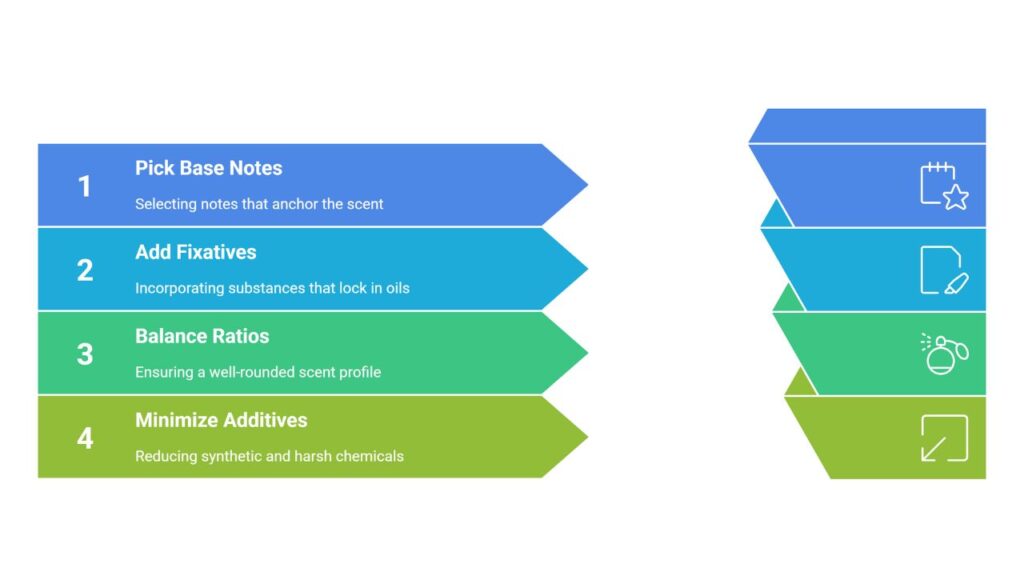
I love all-natural perfumes. They reduce synthetic chemicals while offering lasting aroma. If you want to learn how to make long lasting perfume from essential oils, focus on good fixatives and the right blends.
Pick Potent Base Notes
Base notes anchor your perfume. They evaporate slowly. Frankincense, patchouli, cedarwood, and sandalwood all have strong staying power. If you add them to your formula, you get a more enduring scent.
Boost Longevity with Fixatives
Natural fixatives help lock in oils. Benzoin resin, orris root powder, and labdanum are popular. These substances reduce fast evaporation. That is how many crafters keep a homemade perfume lasting for hours.
Use a Balanced Ratio
If you rely on mostly top notes, your perfume fades quickly. Include enough middle and base notes to ground the scent. A typical recipe might be 10% top notes, 40% middle, 50% base. Adjust if you want a lighter or heavier formula.
Minimal Additives
Avoid too many synthetic solvents. If you prefer natural scents, skip harsh chemicals. You can use a small bit of grain alcohol or keep it purely oil-based. If you do add a minor preservative, choose a mild, skin-friendly option.
Preservation Tips
- Store your perfume in dark, airtight bottles.
- Keep them out of direct sunlight.
- Check for any off smell or color change after six months or more.
- Test on a small patch of skin to ensure no irritation.
A natural blend can last well if you handle it carefully. I have found that warm, spicy base notes often linger longer than bright, citrusy oils. If you must have lemon or bergamot, combine them with a strong fixative. That helps them hold on.
These steps let you enjoy truly natural, custom scents that do not vanish in an hour. That is the joy of learning how to make your own perfume with essential oils for a long-lasting effect.
DIY Projects and Creative Ideas
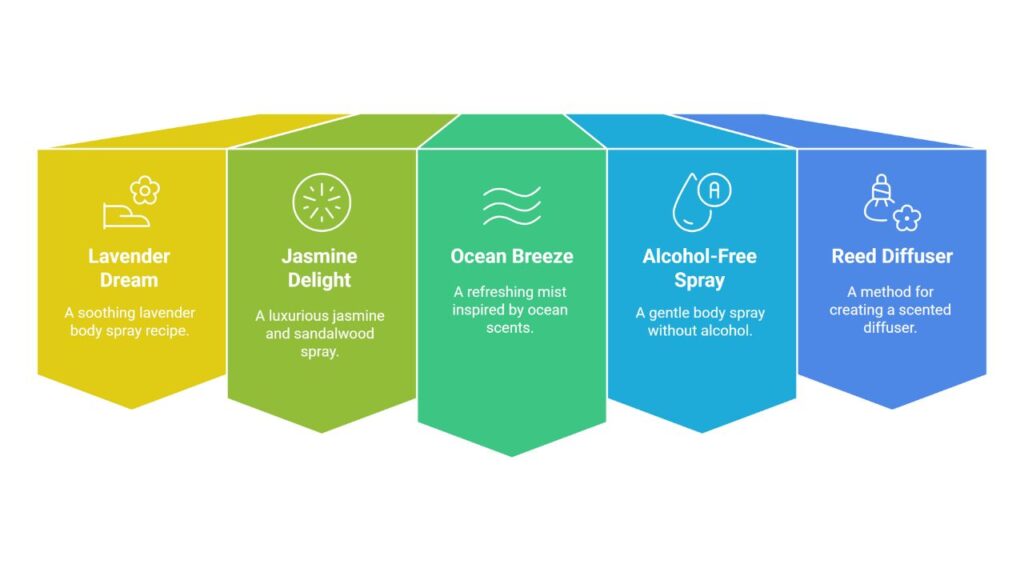
I love customizing scents for different moods. Some days I want a lavender-themed body spray. Other times I crave an ocean-inspired fragrance. If you wonder how to make homemade perfume with essential oils for these themes, here are some fun ideas.
Lavender Dream Perfume
Combine lavender, bergamot, and a hint of vanilla. Keep it oil-based if you want a soothing roll-on. This is great for relaxation before bedtime.
Jasmine Delight Spray
Use jasmine absolute with a few drops of sandalwood. Dilute in vodka or perfumer’s alcohol. Age for a week. This floral spritz feels luxurious.
Ocean Breeze Mist
Mix spearmint, eucalyptus, and a light floral like ylang-ylang. Use distilled water and a small amount of alcohol. Spray lightly on clothes for a refreshing vibe.
Alcohol-Free Body Sprays
If you want no alcohol, rely on distilled water and a solubilizer like polysorbate 20. That keeps oils from separating. Add sweet orange or lavender for a soft daily mist.
Reed Diffuser Variation
Pour your chosen essential oil blend into a glass jar with a neutral carrier (like fractionated coconut). Insert reeds. Flip them every few days. You can create a beachy diffuser with cedarwood, lime, and a drop of rosemary.
Example
| Project | Key Oils | Base |
|---|---|---|
| Lavender Dream | Lavender, Bergamot, Vanilla | Jojoba or Sweet Almond |
| Jasmine Delight Spray | Jasmine, Sandalwood | Perfumer’s Alcohol |
| Ocean Breeze Mist | Spearmint, Eucalyptus, Ylang | Distilled Water + Alcohol |
Experimenting is easy. You learn how to make a perfume out of essential oils that fits any theme. You can also make gift sets. Label them with neat tags. Those personalized items impress friends and family.
Advanced Techniques and Tips
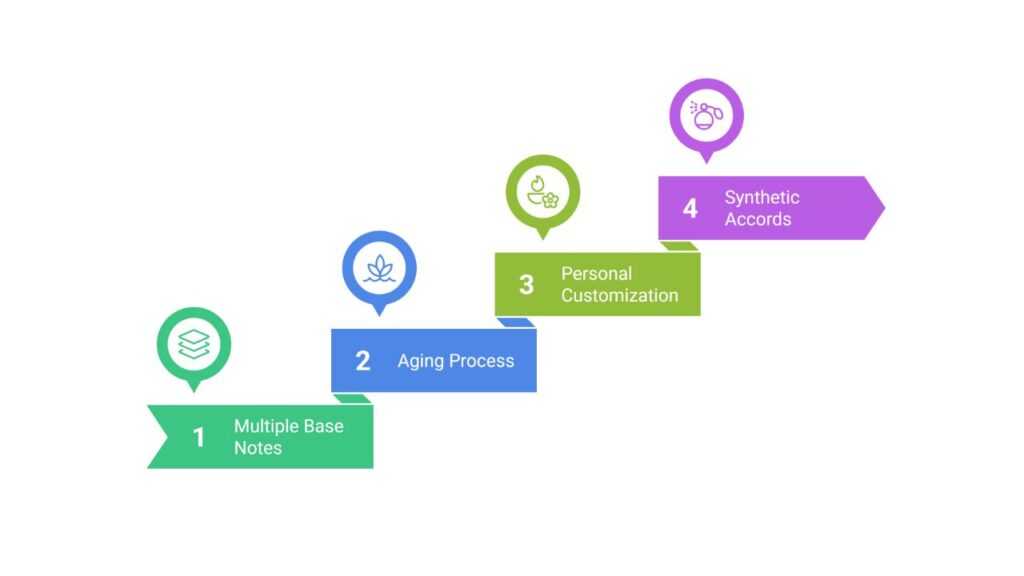
Once you master simple blends, you might want more complexity. I love layering scents with different aroma molecules. If you want to know how to create perfume from essential oils that feels pro-level, try these tips.
Create Depth with Multiple Base Notes
Instead of one base note, combine two or three. That produces a deeper dry-down. For example, blend vetiver with cedarwood and a hint of labdanum. Each layer reveals itself over time.
Aging for Complexity
Some perfumers mature their mixtures for weeks or months. They store them in dark, cool places, shaking them occasionally. Aging helps essential oils merge seamlessly. If you do this, keep careful notes on timing.
Customization for Personal Use
Try small batch experiments. Keep each trial around 5 ml or less. If you love the outcome, scale up. If not, adjust the ratio. This method helps you refine your brand if you ever sell homemade perfume.
Consider Synthetic Accords
If you want to emulate famous scents like “Creed Aventus,” you can incorporate aroma chemicals or isolates. That is advanced. It requires more research into safe usage rates. Some crafters enjoy the challenge.
Remember to track every step. That way you can replicate successes. Learning advanced methods takes patience. But the results feel rewarding.
Packaging and Presentation
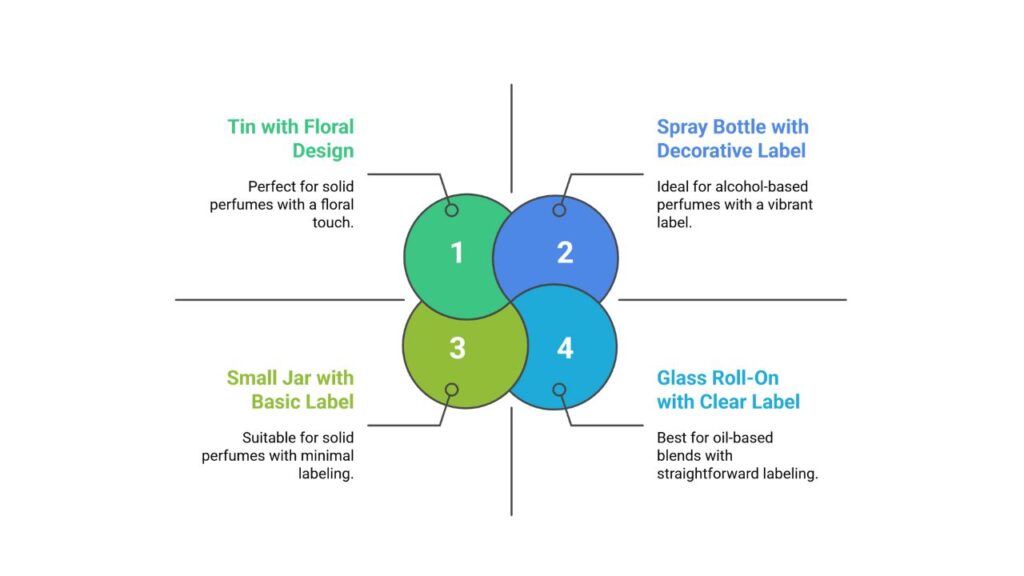
I enjoy turning my homemade perfumes into beautiful gifts. Good packaging elevates the final product. If you’re learning how to make homemade perfume, remember the finishing touches count.
Bottling Options
- Glass Roll-Ons: Ideal for oil-based blends. They travel well and minimize leaks.
- Spray Bottles: Great for alcohol-based perfumes or body mists. Pick dark glass to protect essential oils from light.
- Small Jars: If you make solid perfume, try tins or tiny jars. They look cute and seal tightly.
Labeling
Write the scent name and date. If you want a professional look, print small stickers. Include the main essential oils if you plan to share or gift it. That helps people understand what they are applying.
Creating Attractive Labels
- Keep it simple. Pick a color scheme that matches the scent theme.
- Use waterproof paper if your label might get damp.
- Add personal touches like floral designs or subtle patterns.
Gift Presentation
Wrap the bottle in tissue paper. Slip it into a small box with a matching ribbon. For a special set, include a mini body spray or matching hair mist. If you made an ocean-themed perfume, you can decorate the box with seashell stickers.
Example Table: Packaging Ideas
| Bottle Type | Best For | Label Style |
|---|---|---|
| Roll-On | Oil-based blends | Simple text, pastel colors |
| Spray Bottle | Alcohol-based or body mists | Clear label, minimal design |
| Solid Perfume Tin | Solid or balm-like formulas | Rustic or boho theme |
You can see how the format changes your design choices. Keep your containers clean. Sterilize them with rubbing alcohol or soapy water. That step prevents bacteria growth.
You might also consider adding a short note on usage or skin tests. Those details show you care. Handmade perfumes can make wonderful gifts or even small batch products if you plan to sell.
Safety and Regulations
I prioritize safety when I make perfume with essential oils. Natural does not always mean risk-free. Each oil has recommended dilution rates and guidelines. Be sure you follow them to prevent skin irritation.
Safe Dilution
Most essential oils should not exceed 2-5% in final blends for personal use. If you craft colognes, you might go up to 8-10%. But watch for oils like cinnamon or clove, which can be harsher. If you plan to make natural cologne, test on a small patch first.
Allergen Awareness
Some essential oils can cause reactions. People with allergies need to read labels. If you give your perfume as a gift, list key oils. That helps recipients spot potential sensitivities.
Storage Precautions
Keep bottles away from children or pets. Some oils can be toxic if ingested. Also, ensure caps are secured. Proper labeling with the date helps you track freshness. Most homemade blends last 6-12 months if stored correctly.
Selling Considerations
If you decide to sell your homemade perfume, look into local rules. Certain regions require listing ingredients or following cosmetic regulations. You might need standard testing or a safety assessment. That helps ensure your product meets legal standards.
Key Safety Reminders
| Factor | Notes |
|---|---|
| Dilution Levels | Stay within 2-5% for daily wear to avoid irritation. |
| Patch Testing | Apply a small amount to see if any redness or itching occurs. |
| Labeling | Include known allergens like nut oils or strong fragrances. |
| Child Safety | Store in a locked area. Keep out of their reach. |
Ethanol or Alcohol Use
Handle high-proof alcohol with care. Keep it away from flames. Ventilate your workspace if you make large batches. Watch for local shipping laws if you distribute alcohol-based products.
Remember that safety ensures a worry-free experience for everyone. Homemade perfume can be lovely, but only if you do it responsibly. If you need more guidance, check local guidelines. Meanwhile, keep exploring fun creative blends. For more fragrance tips, visit Perfumsy.com.
